
Space Monitoring For Green Plantains In Rainfall Season
In Nicaragua, it is estimated that 40,000 hectares of green plantains were cultivated in 2022, generating sources of employment throughout the supply chain up to regional exports. Such a production scale has contributed $18.2 million to the national economy, demonstrating 21.8% growth in value and 6.6% in volume, compared to the previous year .
Consequently, it was only reasonable for a new company FINCATECH to start off by operating in highly lucrative agricultural markets like plantain cultivation. Their aim was to collaborate with local growers, helping them to implement more sustainable agricultural capabilities. With one of the clients, they discovered a widespread challenge that has to do with the effect of heavy rains in the middle of the year.
Inability to tackle a challenge like this could affect local agro operations significantly, that’s why the FINCATECH team was looking for solutions that would help them advise on maximizing the efficiency of production in a quick and cost-effective manner. By implementing EOSDA Crop Monitoring, they ushered in the new and promising niche of precision agriculture, which, among other benefits, helped them to distinguish themselves from the competition that preferred older approaches.
In this case study, we will explore how using remote sensing and data analytics facilitated a more efficient development of FINCATECH’s agricultural consulting with one of its clients in Nicaragua.
Overview: About FINCATECH
FINCATECH is an emerging social and triple-impact enterprise that promotes the adoption of inclusive digital agriculture in Nicaragua, with the aim of enabling small and medium producers to improve plantation yields and prepare for the effects of climate change on production, while reducing the impact on the environment and benefiting local populations.
This agricultural company is known for promoting associativity and the collective growth of local producers in order to improve access to markets and agricultural technologies. FINCATECH is formed by a team of experts in climate change and sustainability, having also a team of agronomists, who act as consultants in digital agriculture services. It has launched as a pinnacle of the project “Promoting inclusive digital agriculture in Nicaragua” by the Centro Empresarial Pellas (CEP) in collaboration with the Open Digital Agriculture Platform for Efficiency and Sustainability (ODAPES) in 2021.
They started using crop monitoring software to aid a small agricultural producer in Nicaragua in reducing the negative impact of heavy rains on their plantations while managing yields more efficiently by maximizing the benefits of precision agriculture assessments.
Challenge: Heavy Rains, New Plantation, Lack Of Data
In 2022, a small agricultural producer contacted FINCATECH looking for help with their new production sites. The area of interest was a new green plantain field that was cultivated for the first time that season, having been managed with a micro-sprinkler irrigation system. As you can see in the photos, the plants are quite young (since plantain is a perennial, it can reach 5 meters in height when mature).
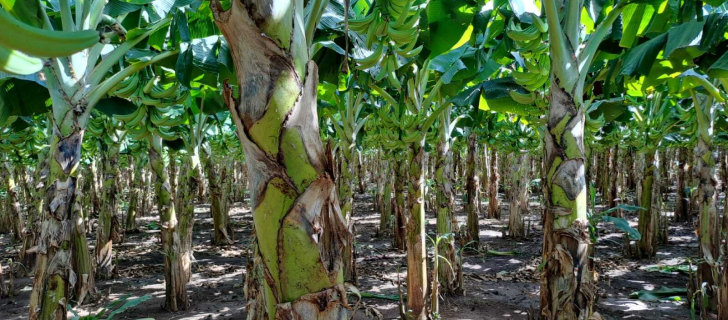
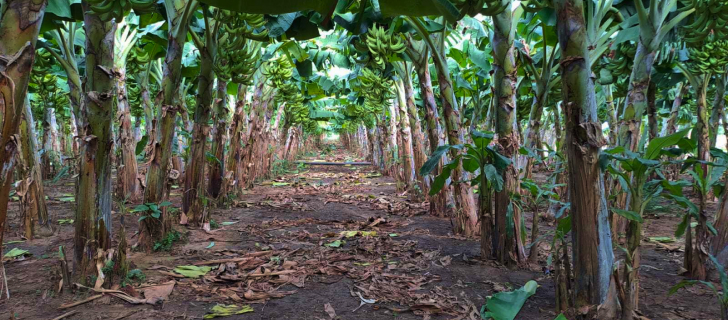
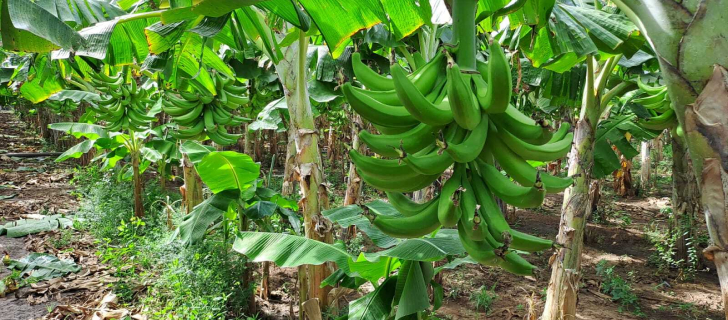
The plantation is located in the region of Tisma, in the Santa Elisa and San Jerónimo farms that are part of an agricultural company dedicated to the planting and marketing of bananas and coffee. In this region, plantain cultivation has grown considerably in the last five years and it is currently one of the most important crops, together with rice, peanuts, and sugar cane.
The green plantain is a tropical fruit native to Southeast Asia belonging to the family Musaceae (it is a triploid hybrid of Musa acuminata and Musa balbisiana). It is a perennial herbaceous plant of large size (3.5 – 5 meters high). Plantains are considered to be grass because their aerial parts die when the growing season ends and perennial because the base of the plant (rhizome) arises from a shoot called son, which replaces the mother plant. The time between planting and harvesting bunches is 9 to 12 months.
During the year 2022, the main challenge was that the rainy season in Nicaragua was influenced by the climatic phenomenon called “La Niña”. Starting in August, rainfall increased by approximately 77% of historical averages, caused by the influence of hurricanes Ian, Julia, and tropical storm Karl. August and September saw 40% of the total seasonal rainfall, which caused over-saturation of the soils and affected planting in the lower zones of the cultivated areas. Runoff and soil saturation caused stress to the plantation, due to soil loss and lack of aeration in the root system, which reduced nutrient absorption capacity, as evidenced by a drop in leaf emission.
FINCATECH wanted to help the producer to gain better control over the crop yields, making sure that unfavorable weather conditions won’t affect the business goals. At the same time, the soil productivity of the given field had to be assessed using historical satellite data to determine the best long-term strategy.
EOSDA Crop Monitoring
Fields monitoring platform, leveraging high-resolution satellite images to identify and react to any changes remotely!
Solution: Monitoring Vegetation Indices, Productivity Mapping
FINCATECH used several features of the EOSDA Crop Monitoring platform for this client:
- Monitoring with NDVI (Normalized Difference Vegetation Index) and NDMI (Normalized Difference Moisture Index)
- Zoning to analyze the needs of specific plantation plots
- Scouting for validation of satellite data.
- Productivity maps for historical data analysis.
The platform account was managed by two professionals who coordinated the team, along with five agronomists who were in charge of scouting, data interpretation, and advisory. The FINCATECH team also used mobile alerts, available in EOSDA Crop Monitoring app.
Using the Monitoring view, on August 1, 2022, vegetation stress was identified in 36% of the cultivated areas with NDVI values between 0.3 and 0.6.

Experts could observe that other fields did not present such low levels of NDVI, indicating that there was a high probability of the soil saturation problem in the first field.
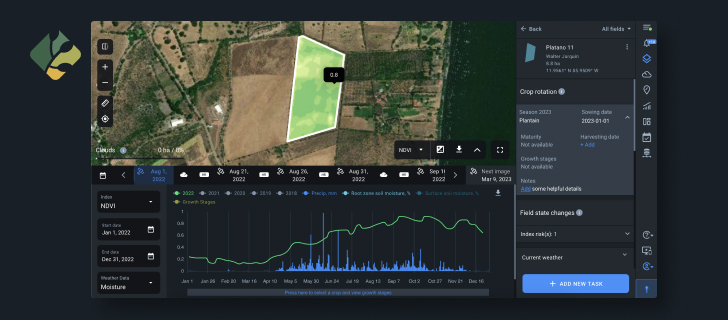
Once the field verification process was complete, the team used the Zoning feature in EOSDA Crop Monitoring to learn that heavy rainfall negatively affected more than half of the field.
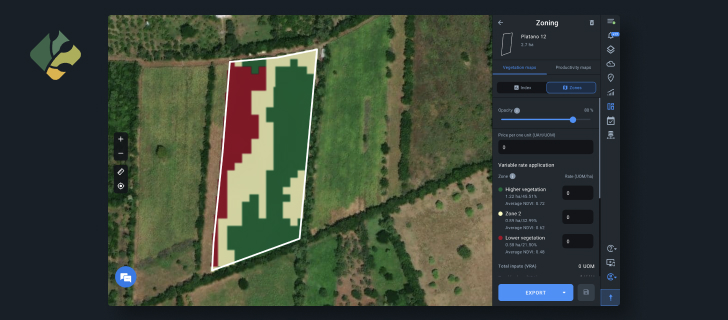
Drainage works were carried out, with drainage channels deepening to reduce waterlogged areas in the identified zones. Humic acid and fulvic acid were applied at the base of the plants to induce root growth, stimulate metabolism and improve nutrient absorption.
According to the image generated by the Zoning view on September 10, 2022, it is evident that the areas of lower NDVI were improved. The high vegetation zones went from 45.51% to 51.93%, while the medium vegetation zones went from 32.99% to 35.69%, and the low vegetation zones went from 21.50% to 12.38%.
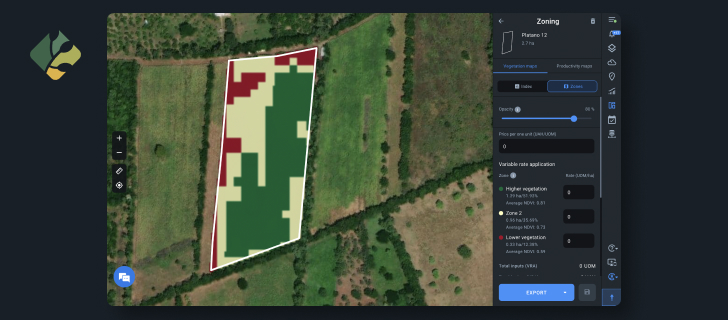
Ripe green plants absorb most of the visible light and use it for photosynthesis, reflecting more of the invisible near-infrared light. Conversely, water reflects all wavelengths of visible light and invisible near-infrared almost equally. NDVI index gets higher when there’s less visible light and more invisible. So, in fields like green plantains, you might see high NDVI before the rain, and a sudden drop when the area is flooded with water (because water reflects visible light that is comparable with the reflection of invisible near-infrared, thus lowering NDVI). However, if you want to accurately measure the vegetation efficiency at that particular time, you need to distinguish between the plants and the water, because the plants are green and they are still there but due to high water, the NDVI is messed up. Try mixing NDWI with NDVI or NDWI with MSAVI in your research to see the plants in green and water in magenta/purple colors. This will help to deal with extreme flooding while obtaining accurate statistics for productivity.
After this experience, a Productivity Map was created for the period of 2016 to 2021. The year 2022 was eliminated to avoid the statistics being affected by an especially rainy year. The given selection also demonstrated a considerable concentration of precipitation in this field during the same seasons over the previous years. It was possible to identify that 69.9% of soils in the area of interest are of low productivity, so experts recommended allocating this field to another productive activity.
Such a conclusion was made after a thorough cost-benefit analysis. Theoretically, the producer could install drainage systems and carry out leveling so that the field wouldn’t get flooded in the future. But the cost of such investments was unreasonably high for such a relatively small field and the amounts of crops that it can potentially produce. The Productivity Map helped the FINCATECH experts to perform detailed assessments and come up with informed solutions.
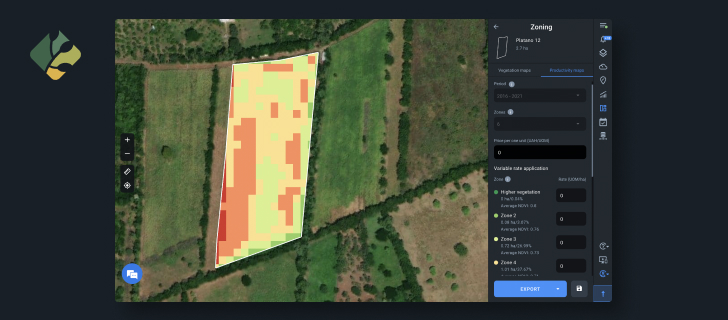
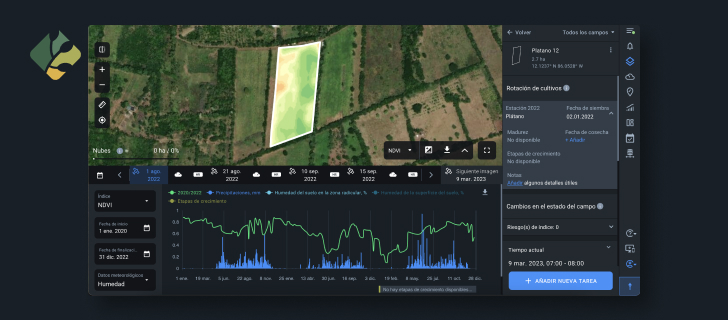
Correlating productivity maps with crop types will enrich your analytical conclusions (e.g. what’s good for rice isn’t good for plantains). Try including ground truth data points or Crop Classification by EOSDA for larger territories in your research. Determine the bad-medium-good NDVI range for every crop type individually and run statistical tests including those values.
Outcome: Crop Resiliency, Efficient Productivity Assessment, Pioneering In Precision AgriTech
In regions like Nicaragua, it is evident that climate change is causing much variability in the behavior of rainfall. It is challenging to predict short periods of time when the rainwater will be concentrated in the fields, causing strong currents and floods that affect crops during the growing season.
EOSDA Crop Monitoring has proven to be a valuable source of information for a detailed assessment of the plantation’s health. Agronomists at FINCATECH have been able to draw actionable conclusions for local producers, helping them to deal with extreme rainfall in the season of 2022 and advising on further development strategies.
There was a little bit of a learning curve for the producers because they have never worked with satellite imagery analytics before collaborating with us. The plantation is managed in a traditional way, so we had a chance to demonstrate that digital agriculture can be efficiently used to the benefit of small and medium plantain producers.
Fincatech successfully demonstrated its commitment to developing the skills of a local team of agronomists, enabling them to serve as “Agronomist Advisors in Digital Agriculture”. Their role is to implement EOSDA Crop Monitoring tools in collaboration with other producers nationwide, with the mission of enhancing the sustainable performance of plantations while reducing the consumption of agricultural inputs.
About the author:
Petro Kogut has a PhD in Physics and Mathematics and is the author of multiple scientific publications. He is the Soros Associated Professor as well as the head of the department of differential equations in the Oles Honchar Dnipro National University and has received a number of grants, prizes, honorary decorations, medals, and other awards. Prof. Dr. Petro Kogut is a science advisor for EOSDA.
Recent articles

Analyze 2025 & Plan Your Best Year Yet: LandViewer Christmas Offer
It’s the most wonderful time of the year! The Christmas holidays are here, and so is your chance to analyze 2025 and plan a prosperous 2026 with more affordable Pro plans in LandViewer.

EOSDA Models Climate Change Impact On Sugarcane Yields
EOSDA modeled future temperature, rainfall, and other climate impacts on Veracruz sugarcane. The results help growers plan long-term adaptation strategies, including timing, varieties, and irrigation.

EOSDA LandViewer Black Friday Sale: Exclusive Offers & Giveaway
This Black Friday, LandViewer offers new users the chance to save on monthly plans, get extra months with yearly subscriptions, and participate in a free annual plan giveaway.